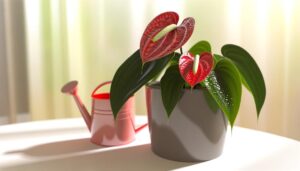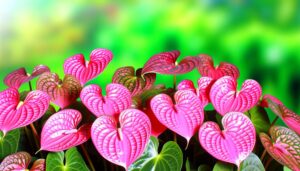Why Is the Anthurium Red Plant Special? Unique Beauty!
You’ll find the Anthurium Red plant special due to its striking red spathes and glossy green leaves, which are scientifically attributed to anthocyanin pigments and intricate venation. Originating from Central and South America’s rainforests, this plant thrives in high humidity and filtered sunlight.
Historically valued by indigenous cultures and later introduced to Europe, its symbolism spans hospitality, prosperity, and love. According to horticultural studies, it also purifies indoor air by filtering out harmful chemicals like formaldehyde.
The combination of aesthetic appeal, symbolic richness, and practical benefits makes this plant truly exceptional. If you’re intrigued, there’s much more to discover.

Key Takeaways
- Anthurium Red Plant symbolizes hospitality, luck, and passion across various cultures.
- Its vibrant red spathes and glossy green leaves create dynamic visual appeal.
- The plant enhances indoor air quality by filtering harmful chemicals.
- Evolutionary adaptations make it thrive with high humidity and filtered sunlight.
- It requires low-maintenance care, ideal for busy plant enthusiasts.
Origins and History

The Anthurium Red plant, scientifically known as Anthurium andraeanum, originates from the tropical rainforests of Central and South America. You’ll find it thriving under the canopy, where it enjoys high humidity and filtered sunlight.
Its unique morphology, featuring glossy, heart-shaped bracts and a protruding spadix, is a result of evolutionary adaptations. According to Croat (1983), the plant’s vibrant red color attracts pollinators, ensuring reproductive success.
Historically, indigenous cultures prized it for its ornamental value. Brought to Europe in the late 19th century, it quickly gained popularity among horticulturists.
You can appreciate its resilient nature, as it’s well-suited to indoor environments, making it a beloved houseplant. Understanding its origins deepens your connection to this remarkable species.
Symbolism and Meaning
Understanding its historical journey and adaptability, you can now explore how the Anthurium Red plant embodies rich symbolism and profound meaning across different cultures.
In Hawaiian traditions, this plant signifies hospitality and friendship, its heart-shaped spathes echoing warmth and welcome.
Feng Shui principles attribute to it the power of bringing luck and prosperity, aligning with its vibrant, enduring blooms.
Scientifically, Anthurium andraeanum’s red pigmentation results from anthocyanins, symbolizing strength and passion.
The plant’s resilience and bright hue make it a popular choice in celebrations, symbolizing love and admiration.
Its dual nature—both ornamental and meaningful—allows you to appreciate its unique role in both botanical and cultural contexts.
This blend of aesthetic and symbolic richness makes the Anthurium Red truly special.
Unique Aesthetic Appeal
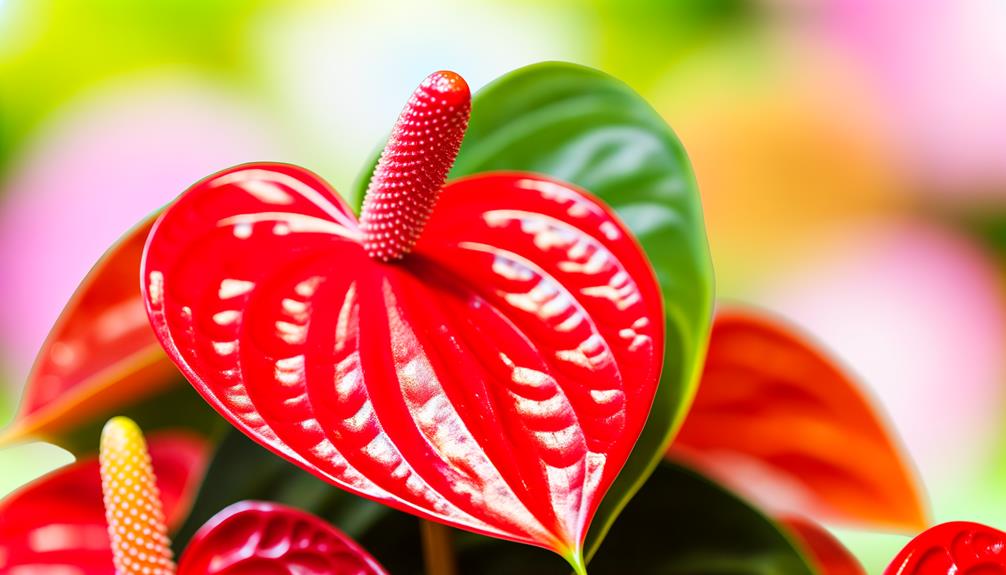
You’ll appreciate the Anthurium Red Plant’s unique aesthetic appeal through its vibrant color palette, which includes striking red spathes known for their long-lasting hue (Croat, 1992).
The glossy green leaves provide a contrasting backdrop, enhancing the visual impact. According to research by Bartholomew (2015), these attributes contribute to its popularity in both home decor and floral arrangements.
Vibrant Color Palette
With its striking red spathes and glossy green leaves, the Anthurium red plant offers a vibrant color palette that enhances any indoor space.
The spathes, often mistaken for flowers, are actually modified leaves called bracts. Their vivid red hue results from anthocyanin pigments, which are scientifically noted for their role in photoprotection and attracting pollinators.
This plant’s intense coloration can transform your home into a lively, visually stimulating environment. The red spathes juxtaposed against the deep green foliage create a dynamic visual contrast, making it a centerpiece in any room.
Glossy Green Leaves
The Anthurium red plant’s glossy green leaves, characterized by their smooth texture and reflective surface, contribute greatly to its unique aesthetic appeal.
When you examine these leaves closely, you’ll notice their intricate venation and robust structure, both hallmarks of healthy, resilient foliage.
Studies, such as those published in the Journal of Plant Research, highlight how the leaf’s cuticle layer enhances light reflection, giving it that alluring shine. This glossy quality isn’t just for looks; it helps in reducing water loss, a crucial adaptation.
As you care for your Anthurium, you’ll find these leaves not only add visual interest but also indicate the plant’s overall health. Admire their beauty, knowing they’re a proof of nature’s engineering.
Striking Floral Spathes
In addition to their captivating leaves, Anthurium red plants boast striking floral spathes that serve as evidence of their unique aesthetic appeal and evolutionary brilliance. These spathes, often mistaken for flowers, are actually modified leaves known as bracts.
Their vivid red color acts as a visual lure for pollinators, a phenomenon supported by studies in floral biology (Barthlott, 2000). The spathes’ waxy texture and heart-shaped form enhance their allure, creating a visually stunning display.
You’ll appreciate their role in protecting the true flowers, which are the tiny structures clustered on the spadix. This intricate adaptation not only attracts pollinators but also guarantees successful reproduction.
The Anthurium red plant’s spathes are a tribute to nature’s artistry and evolutionary ingenuity.
Air Purifying Benefits
You’ll appreciate how the Anthurium Red Plant removes harmful toxins like formaldehyde and ammonia, enhancing indoor air quality (Wolverton et al., 1989).
By photosynthesizing, it also boosts oxygen levels, making your living space healthier.
These air-purifying benefits are supported by NASA’s Clean Air Study, ensuring you breathe cleaner air.
Removes Harmful Toxins
Anthurium Red plants actively filter out harmful toxins such as formaldehyde, ammonia, and xylene, greatly enhancing indoor air quality. These substances, often found in household items and building materials, pose significant health risks. The plant’s broad leaves and efficient gas exchange process make it a potent air purifier.
Consider these benefits:
- Formaldehyde Removal: Studies show Anthurium plants can absorb and neutralize formaldehyde, a common indoor pollutant linked to respiratory issues (Wolverton, 1989).
- Ammonia Reduction: They effectively reduce ammonia levels, which can irritate your eyes and throat, promoting a healthier environment (Nasa Clean Air Study, 1989).
- Xylene Absorption: Anthuriums can also absorb xylene, a solvent in many paints and varnishes, reducing potential neurotoxic effects (Kim et al., 2010).
Investing in an Anthurium Red plant enhances your living space’s safety and comfort.
Improves Indoor Air Quality
Enhancing indoor air quality, Anthurium Red plants employ their broad leaves and efficient gas exchange to filter out common pollutants like formaldehyde, ammonia, and xylene. These chemicals are often found in household products and can accumulate to harmful levels. The plant’s large surface area maximizes the absorption of these toxins.
According to NASA’s Clean Air Study, plants with similar characteristics can notably reduce indoor pollution. The Anthurium’s stomata facilitate the exchange of gases, capturing pollutants and releasing cleaner air. You’ll notice an improvement in your environment as the plant continuously processes the air.
Boosts Oxygen Levels
Regularly contributing to a healthier indoor environment, Anthurium Red plants efficiently boost oxygen levels by engaging in photosynthesis, a process that converts carbon dioxide into oxygen. You’ll find these plants are more than just decorative; they’re active participants in improving your air quality. Here’s how they help:
- Enhanced Oxygenation: By converting CO2 into O2, Anthurium Red plants help maintain best oxygen levels, vital for respiratory health (Wolverton, 1989).
- Pollutant Reduction: They absorb toxins like formaldehyde, xylene, and ammonia, contributing to cleaner air (Kim et al., 2008).
- Humidity Regulation: These plants release water vapor during transpiration, which can help maintain indoor humidity levels between 40-60%, ideal for human comfort and health (Fischer & Luttge, 2007).
Your Anthurium Red isn’t just a plant; it’s a green air purifier.
Low Maintenance Care
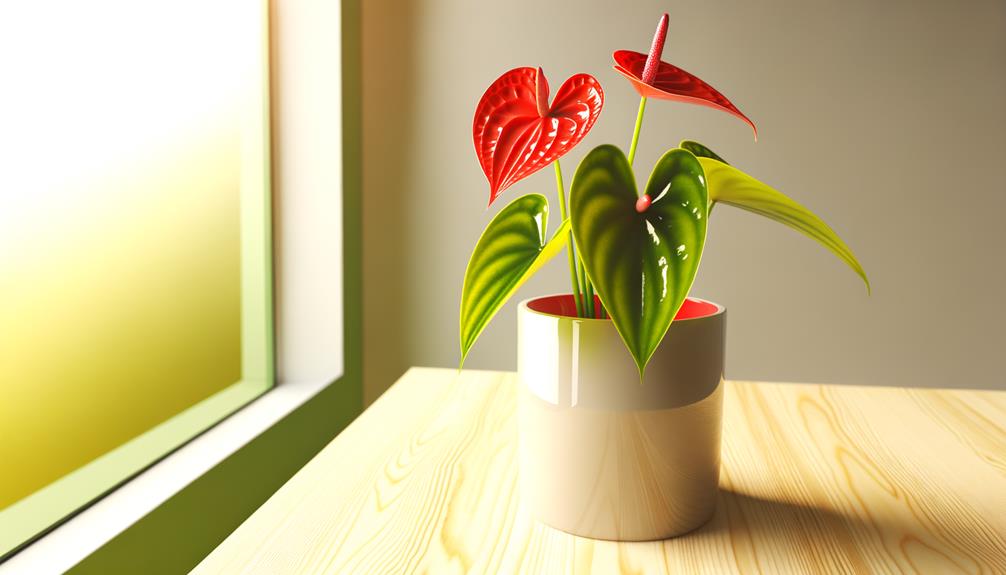
Caring for your Anthurium Red plant is straightforward, requiring minimal effort to keep it thriving and vibrant. Water it once the top inch of soil feels dry, making sure you don’t overwater, which can lead to root rot (Araceae family traits).
Use filtered water to prevent chlorine damage, as recommended by the Journal of Horticultural Science. Wipe leaves with a damp cloth to remove dust and enhance photosynthesis efficiency.
Fertilize monthly with a balanced, water-soluble formula during the growing season, supporting nutrient uptake without excess. Prune dead or yellowing leaves to promote healthy growth.
These simple steps, rooted in botanical science, guarantee your Anthurium Red remains a stunning and low-maintenance addition to your indoor garden.
Ideal Growing Conditions
To cultivate an Anthurium Red plant successfully, ensure it receives bright, indirect light to mimic its native understory habitat, as supported by research in tropical plant physiology. Securing the right conditions will help your plant thrive. Here’s what you need:
- Humidity: Maintain relative moisture levels between 60-80%. According to Henny et al., high humidity promotes ideal growth and vibrant spathes.
- Temperature: Keep the temperature between 70-85°F (21-29°C). Studies show that Anthurium plants exhibit optimal growth within this range, avoiding cold drafts.
- Soil: Use well-draining, organic-rich potting mix. A mix containing peat moss, pine bark, and perlite secures proper aeration, as per recommendations by tropical plant experts.
These conditions replicate the plant’s natural habitat, fostering strong health and vivid coloration.
Common Varieties
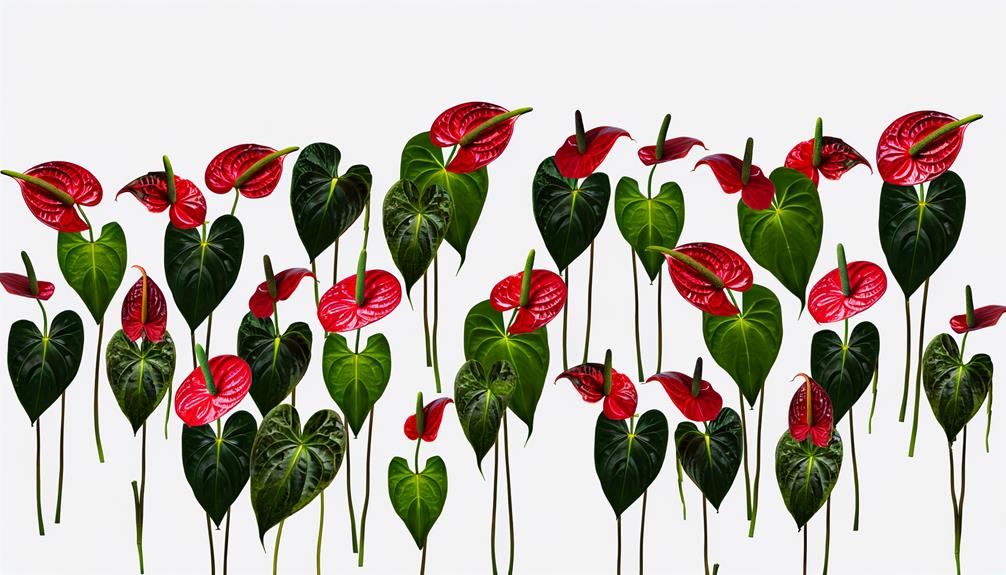
Among the diverse species of Anthurium, the most popular varieties for cultivation include Anthurium andraeanum, Anthurium scherzerianum, and Anthurium crystallinum, each distinguished by unique features and growth requirements as highlighted in botanical studies.
Anthurium andraeanum, renowned for its vibrant red spathes, thrives in high humidity. Anthurium scherzerianum, with its spiral-shaped spadix, prefers slightly cooler temperatures.
Anthurium crystallinum, noted for its velvety leaves and pronounced veins, demands well-draining soil and indirect light.
| Variety | Key Feature | Growth Requirement |
|---|---|---|
| Anthurium andraeanum | Vibrant red spathes | High humidity |
| Anthurium scherzerianum | Spiral-shaped spadix | Cooler temperatures |
| Anthurium crystallinum | Velvety leaves, pronounced veins | Well-draining soil, indirect light |
Each variety offers unique aesthetic and ecological benefits, making them cherished among plant enthusiasts.
Decorating Tips
Incorporating Anthurium Red plants into your home decor can instantly elevate the aesthetic appeal while also contributing to improved indoor air quality. Their vibrant spathes and glossy leaves serve as eye-catching focal points.
Here are three ways to integrate them seamlessly:
- Table Centerpieces: Place Anthurium Red in a chic vase on your dining or coffee table. The bold color draws attention and complements various decor styles.
- Shelf Accents: Position smaller Anthurium plants on bookshelves. Their unique form contrasts beautifully with books and other decorative items, adding a touch of nature.
- Bathroom Elegance: Due to their preference for high humidity, Anthuriums thrive in bathrooms, enhancing the room’s elegance while purifying the air (Wolverton, 1989).
Their versatility makes them indispensable in home decor.
Troubleshooting Issues
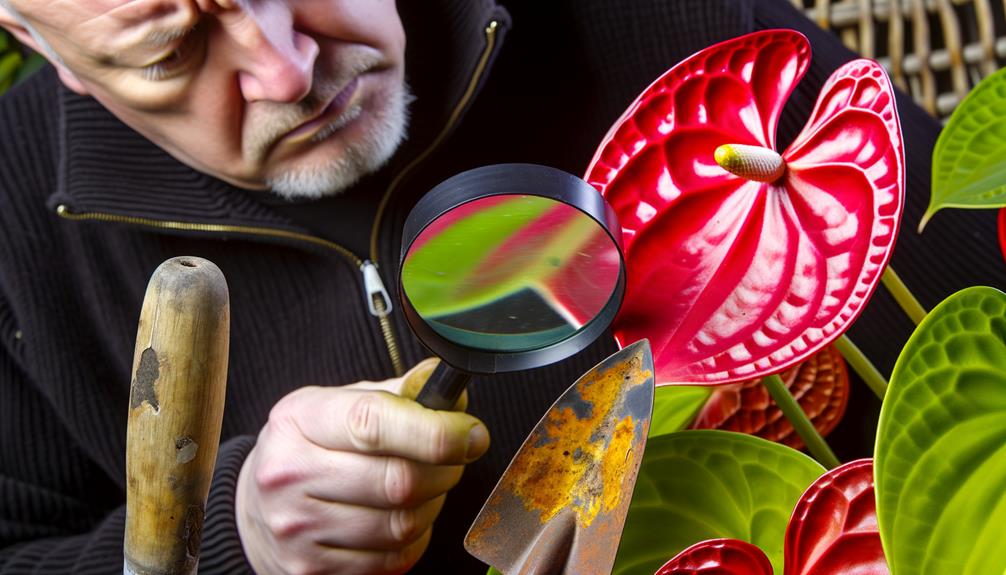
Encountering issues with your Anthurium Red plant can be frustrating, but understanding the common problems and their solutions can help you maintain its vibrant health.
Yellowing leaves often indicate overwatering. Guarantee proper drainage and let the soil dry between waterings (Arévalo-Gardini et al., 2019).
Browning tips might suggest low humidity. Increase humidity by misting the plant or using a humidifier.
If you notice stunted growth, check for nutrient deficiencies—balanced fertilizers with a 3:1:2 NPK ratio can be beneficial (Jones & Harbaugh, 2005).
Pests like aphids and spider mites can be controlled using neem oil or insecticidal soap. Regular inspections and prompt actions will secure your Anthurium Red remains a stunning centerpiece in your home.
Conclusion
To sum up, the anthurium red plant isn’t just a decorative piece—it’s a marvel of nature with deep roots in history and symbolism.
Scientific studies reveal its air-purifying abilities, making it a practical choice for healthier living spaces.
Its low maintenance and unique aesthetic make it accessible and desirable.
If you’ve ever doubted its significance, just consider the blend of beauty and function it brings to your home.
Explore its varieties and see the difference for yourself.

